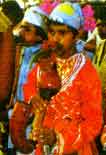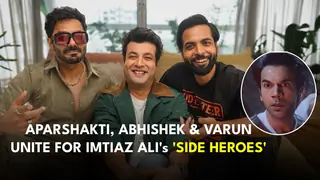Gujarati and Indian Music
Origin:
An observer of the cultural scenario of Gujarat may wonder why better appreciation of music is now very much visible among Ahmedavadis. Well, you will be surprised that the sweet inspirations were nothing new in Gujarat. The state has already been vibrating to the stimulus of sound waves produced by the great musicians of Gujarat centuries ago.
Haveli Sangeet:
The fascination of music for the people of Gujarat was curiously illustrated by the fact that several Gujaratis have enriched the tradition of Hindustani classical music. Musicologists and historians trace the genesis of classical music to the Haveli Sangeet of Vallabhacharya, the pioneer of the movement, which was akin to Prabhanda, a literary from peculiar to Gujarat.
Narsinh Mehta:
The impact of this devotional singing is perceptible in the compositions of Narsingh Mehta, the great Vaishnavaite poet of Junagadh during the period 1414 to 1481. Narsingh Mehta is said to have worked a variety of miracles, particularly when he sang his favourite raga "Kedar" In the history of music, Narsingh Mehta was the most accomplished composer from Gujarat. His lyrical work, "Vaishnava Janato" which was so dear to Gandhiji, remains as a musical marvel without any cause wonder to the people of Gujarat even today.
Folk: Raas-Garba
The most popular amongst the Folk music is, Raas-Garba. The annual Navratri Utsav, or Festival of Nine Nights, provokes the cities of Gujarat into light, colour, dancing and music, during Saptember-October. Navratri is held throughout Gujarat, at small villages as well as great cities. Amba Mata, the earth goddess bestowing strength and power against the forces of evil, enjoys special attention during Navratri by Puja in temples and dances of the Ras Garba tradition. These dances normally begin at eleven at night and continue till dawn, at various sites, in different areas in each city.
Moghul era:
Swami Vallabhdas who hailed from Gujarat had given himself up to the Swaminarayan sect from his childhood to serve God through music. Aditya Ram, State Musician of Jamnagar who lived in the 18th century was credited to have popularised the singing style of Dhrupad Sangeet. Baiju Bavara, who sang with the legendary Mian Tansen of Akbar's court hailed from Champaneer in Gujarat. The 16th century Nawab of Ahmedabad, Bahadur Shah was a keen music lover and it was he who patronised Baiju Bawara's music. As a Tribute to his mentor, Baiju Bawara created the Morning raga, Bahadur Todi in honour of the Nawab.
Connoisseurs of music are all too familiar with the miracle associated with Tansen's rendition of raga Deepak. According to the story prevailing in Gujarat, Tansen after singing the melody, began to suffer from unbearable heat within his body and in sheer exasperation, he absconded from Delhi and came down to Vadanagar in North Gujarat in search of a cure for his ailment.
A Kindly brahmin musician offered shelter to Tansen at Vadanagar. He was quick to surmise the cause of Tansen's suffering and asked his gifted daughters, Tanna and Riri, who were accomplished singers to render the raga "Malhar", associated with the rainy season. Their rendition had a miraculous effect on Tansen and he was cured of his affliction.
Overjoyed, Tansen returned to Akbar's court and told the emperor of the cure he had. Pleased with the result, the Mogul Emperor sent a special messenger to bring the singing sisters to his court. The girls declined the emperor's invitation. Incensed by the girls' impudence, Akbar ordered his army to invade Vadanagar to bring the two musicians. Upon Seeing the approaching army, the girls immolated themselves Tana-Riri music festival in Vadanagar is now a yearly ritual to perpetuate the memory of the girls who sacrificed their lives to uphold the musical tradition of Gujarat.
Gaekwads:
Bhavanagar, Porbandar, Sanand and Baroda were the princely states which accorded patronage to music in Gujarat. But the pride of place among these princely patrons must go to Maharaja Sayaji Rao Gakewad of Baroda who brought a transformation of his State in the field of education, art and culture. Baroda, which is acclaimed as the cultural capital of Gujarat, boasts of a University with faculty of music, dance and drama besideds a Kala Bhavan which are monuments to Sayajirao's contribution to fine arts. The first all India Music Conference was held in 1914 in Baroda.
Kambavati, a very popular melody of our times must have had its origin in the city of Cambay, the Hindu name for which was Khambavati, present day Khambhat. Sohini, Bhilaval, Saurashtra Tanka are some of the other ragas in Hindustani music which one their origin to Gujarat. Krishandas Adhikari, who was born in a village called Chilotra in Ahmedabad District was considered to be the best exponent of the modern Khyal singing. The best know exponents of Thumri, the late Khan Sahib Abdul Karim Khan and Sahib Faiyaz Khan adorned the durbar of the Baroda Maharaja.
Pandit Thakur:
The most outstanding educationist of Indian music by evolving a graduate course of instruction which is a great improvement was Pandit Omkarnath Thakur (1897-1968) who had published a series of text books of practical instruction named Sangeetanjali. This great son of Gujarat had devoted his lifetime to the propogation of Hindustani classical music, not only in Gujarat but throughout India.
Gujarati Gazals:
On an equivalent freshness and originality is Gujarati Gazals, the most popular variety commonly known as light classical music or just 'Sugam Sangeet' in Gujarat. However with the passing away of Avinash Vyas, the Gujarati Sugam Sangeet World lost a friend. But a handful of his wellwishers preserve his tradition of singing, the Gujarati Geet. Film music directors, Kalyanji-Anandji continue to enrich the music of Gujarat.
Ahmedabad Today:
Ahmedabad based financial institution named Anagram Finance Limited, a Kasturbhai Lalbhai group company organises regularly a three day classical music festival, it turns out to be another manifestation of the corporate public relation culture in promoting music among the masses of Ahmedabad in Gujarat. During the three day festival, a record number between eight to ten thousand people listen in rapt attention the strains of classical Hindustani ragas in the cool comfort of a sprawling open air theatre sitting cross legged in the traditional, 'baithak' style or in the more comfortable plastic moulded chairs watching stalwarts like Bhimsen Joshi, Pandit Shivkumar Sharma or the charismatic Zakir Hussein for three consecutive days till late midnight.
"Sur Sandhaya Samaroh" started perhaps the first of its kind in such a massive scale where the discerning public was provided with closed circuit television view on giant screens for closer looks at the artists in action. The event took many by surprise, because the general feeling was that the people of Ahmedabad in particular and Gujaratis in general are more concerned with creation of wealth than for developing an ear for music.
The run away success of the three-day festival marks a new vista in the cultural scene of Ahmedabad today. Gujarat, has a lot to offer to Indian classical music.
Edited by vinnie-thepooh - 18 years ago








 Gujarat has preserved folk music in its pure and pristine form by Charans and Gadhavis, a community whose hereditary profession is folk music and folk arts. Lullaby, Nupital songs, festive songs, Rannade songs are the different types of folk songs in Gujarat. Marsias is a peculiar form of singing at the time of death. The Vaishnava cult in Gujarat has produced a special variety of music which can be classified as temple-music.
Gujarat has preserved folk music in its pure and pristine form by Charans and Gadhavis, a community whose hereditary profession is folk music and folk arts. Lullaby, Nupital songs, festive songs, Rannade songs are the different types of folk songs in Gujarat. Marsias is a peculiar form of singing at the time of death. The Vaishnava cult in Gujarat has produced a special variety of music which can be classified as temple-music. The word Garba comes from the word "Garbha Deep", meaning a Light in the inner sanctum of the temple, signifying knowledge (light), as opposed to the darkness (ignorance). In the villages of Gujarat, one would find tradition of a "Light" (Deevo-Kodiyun) in an earthen pot with the holes all around, placed in the center on a stool and brightly dressed ladies move around it clapping their hands in beats and singing Mataji's songs (known as Garba). A betel nut and a silver coin are placed within the pot, called a kumbh, on top of which a coconut is placed. Just as Lord Krishna popularized the Ras dance, Usha the grand daughter-in-law of Lord Krishna is credited to have popularised Lasya Nritya which is known today by the name of Garba Dance. The Garba is traditionally performed during the festival of Navratri ("Nine Nights").
The word Garba comes from the word "Garbha Deep", meaning a Light in the inner sanctum of the temple, signifying knowledge (light), as opposed to the darkness (ignorance). In the villages of Gujarat, one would find tradition of a "Light" (Deevo-Kodiyun) in an earthen pot with the holes all around, placed in the center on a stool and brightly dressed ladies move around it clapping their hands in beats and singing Mataji's songs (known as Garba). A betel nut and a silver coin are placed within the pot, called a kumbh, on top of which a coconut is placed. Just as Lord Krishna popularized the Ras dance, Usha the grand daughter-in-law of Lord Krishna is credited to have popularised Lasya Nritya which is known today by the name of Garba Dance. The Garba is traditionally performed during the festival of Navratri ("Nine Nights"). A fascinating and vivid celebration of dance and devotion, "Navratri" is an inseparable identity of Gujarat that commemorates the workship of nine avatars of the Divine Mother Goddess who supports the entire universe, protects here worshippers and blesses the devotees with eternal bliss. The days are divided and devoted to the trinity of the Goddess ' Durga, the Goddess of Valour; Lakshmi, the Goddess of Wealth and Saraswati, the Goddess of Knowledge and Art ' worshipped as the manifestations of Maha Shakti.
A fascinating and vivid celebration of dance and devotion, "Navratri" is an inseparable identity of Gujarat that commemorates the workship of nine avatars of the Divine Mother Goddess who supports the entire universe, protects here worshippers and blesses the devotees with eternal bliss. The days are divided and devoted to the trinity of the Goddess ' Durga, the Goddess of Valour; Lakshmi, the Goddess of Wealth and Saraswati, the Goddess of Knowledge and Art ' worshipped as the manifestations of Maha Shakti.













